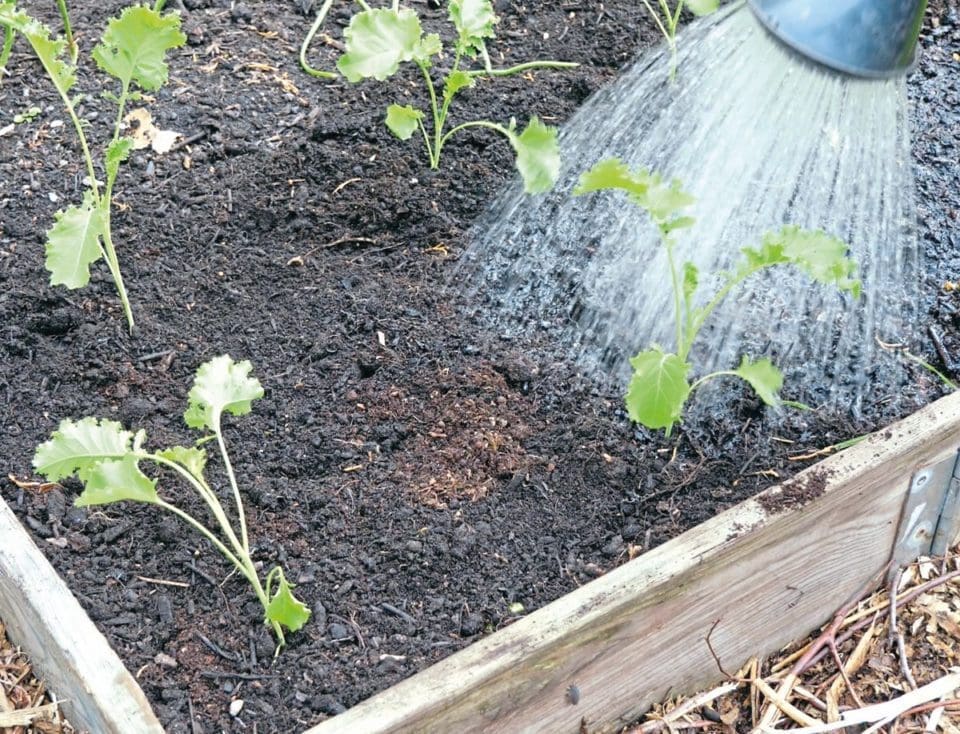Ben Vanheems shares some essential tasks to carry out in your garden and allotment for July.

SOW NOW
Beetroot, cabbage, calabrese, carrots, chicory, endive, Florence fennel, French beans, kale, kohl rabi, lettuce, peas, radish, salad leaves, spinach, spring onion, sprouting broccoli, Swiss chard, turnips
PLANT NOW
Brussels sprouts, cabbage, cauliflower, celeriac, endive, French beans, kale, leeks, sprouting broccoli, strawberries
HARVEST
Aubergine, beetroot, beans (all types), broccoli, carrots, cauliflower, celery, chicory, chillies and peppers, courgettes and summer squash, cucumber, Florence fennel, garlic, globe artichoke, kohl rabi, lettuce, onions, peas, potatoes, radish, salad leaves, shallots, spinach, spring onion, strawberries, Swiss chard, tomatoes, turnips
Harvest time!
At last! Bask in the warmth of the summer sun and – even more exciting – the bounty that this brings, from beetroot by the bunch to beans by the basket load. The great joy of growing your own is that fruits and vegetables can be picked at their finest. No tired, past-their-peak produce for you!
Courgettes should be coming thick and fast. If they’re not, be patient as plants often produce a surplus of male flowers to begin with. Harvest courgettes no bigger than 15cm (6in) long. At this size they have a firm texture and irresistible, almost nutty taste – none of your oversized pappy mush. Don’t overlook the male flowers, which can be stuffed, battered, then fried.
Like courgettes, pick beans regularly to keep them coming. Be thorough so as not to miss any. Enjoy runner beans young, before the pods turn stringy. Beetroots are at their best not much bigger than golf ball size, while there’s no matching tender, finger-thick carrots.
Pinch out beans
Pinch out the tops of climbing beans once they reach the top of their supports. Ensure beans are properly watered to help them set their pods in hot weather.
Pollinate squash
Boost pollination of squash-family plants. Detach a male flower, peel back the petals to expose the stamen, then brush on to the stigmas at the centre of the female flowers.
Harvest garlic
Garlic is ready to harvest when around half the leaves have turned yellow. Lift bulbs with a fork then move to somewhere warm and airy to dry ready for storing.
Final call
This is your last chance to sow a number of vegetable garden staples: Florence fennel, beetroot for winter roots, peas and dwarf French beans.
Get water wise
STEP 1: In hot weather water early in the morning or later in the evening when it is cooler. Don’t be afraid to really douse plants; a thorough soaking is far more effective than a light sprinkle here and there. Go over the area, allow to drain through, then water once again.
STEP 2: Top up mulches around crops after it has rained to slow evaporation. Garden compost is best – spread it at least 1cm (½in) deep. Other options include well-rotted manure, grass clippings, or straw around plants like tomatoes, squashes and, of course, strawberries.
STEP 3: Prioritise watering if you are busy. Seedlings, leafy salads, fruit and pod-forming vegetables, potatoes and, of course, container crops need the most water. Think of ways to make life easier – for example, watering into open-ended bottles set around thirsty crops.
Plant winter brassicas
Set out and plant winter brassicas such as kale, sprouting broccoli, Savoy cabbages and, early in the month, Brussels sprouts. If you haven’t sown any, look in garden centres for ready-to-go plants.
Plant into soil cleared of a previous crop. Firm the soil back down and thoroughly water if it’s dust dry. Kale, cabbage and broccoli can go in at around 45cm (18in) apart in both directions, while sprouts need a little more room – aim for 60cm (2ft). Cover transplants with insect mesh to keep cabbage white butterflies from laying their eggs on the young leaves. Spread a top-up of compost around plants once they have grown on a bit to help feed the soil and, by extension, the plants growing in it.

Pests & Problems
■ POTATO BLIGHT: Warm, humid weather and sticky nights are ideal conditions for potato blight, which is a threat from July. Look out for brown lesions on the leaves. Cut back affected foliage to the ground then leave the potatoes for a few weeks before lifting.
■ CARROT ROOT FLY: The larvae tunnel as they feed, riddling roots with rusty brown castings that render them inedible. Stop egg-carrying females from laying their eggs in the first place by covering susceptible crops like carrots and parsnips with fleece or insect mesh.
■ RED SPIDER MITE: Spider mites are common in hot, dry greenhouses. Up the humidity by damping down – splashing water on to hard surfaces such as paths. Bring severe infestations under control by setting up biological controls of predatory mites.
Under cover

Support act
Proper support is essential if vining greenhouse staples like tomatoes, cucumbers and melons are to reach their full potential. Regularly tie plants to their supports to keep them upright and so the leaves get enough space and light to thrive.
Pinch out tomatoes once they reach the greenhouse eaves. There’s little point allowing plants to grow beyond this point as this only increases the chances of a load of hard, underripe tomatoes in a few months’ time. Sadly, our British summers are only too fleeting and from now we need our end goal in mind: delicious, perfectly ripe fruits. By limiting vegetative growth plants can concentrate on swelling and ripening fruit.
The first fruits are patiently anticipated, but soon they will be coming thick and fast. Check over plants regularly, peering in among the foliage – you don’t want to miss any! Pick fruits as they ripen and enjoy them as fresh as possible. Too many to handle? Lucky you! Turn them into sauces and passatas then freeze.
Patrol for pests
We’re coming into the peak time for greenhouse pests. Regularly inspect plants for common culprits such as whitefly, aphids, mealybugs, scale insects and red spider mites, which are often given away by the fine webbing they weave across affected leaves.
One way to keep an eye on the situation is to set up yellow sticky traps. Make your own by colouring in white cardboard yellow. Smear the card all over with petroleum jelly to make it sticky then hang up among your plants. Take action if lots of one specific pest shows up. As always, making sure plants have everything they need – moisture, nutrients, airflow – will help them to shrug off most pest and disease threats.
Improve tomato fruit set
STEP 1: Frustrated by poor fruit set? Tomatoes are self-pollinating but can be slow to set fruit in less-than-ideal conditions. Improve success by mimicking the buzz pollination of bumblebees. Tap or twang supports every time you are in the greenhouse to help dislodge the pollen.
STEP 2: Another very effective option is to rest an electric toothbrush on the back of each flower for a few seconds. The vibrations shake the pollen free, helping to guarantee successful fertilisation. Revisit flowers every few days to be absolutely sure.
STEP 3: Proper nutrition is essential. Use a feed that is high in potassium and with plenty of trace elements such as magnesium – most purpose-sold tomato feeds should fit the bill. As well as helping power fruit production, this should help to avoid issues like blossom end rot.
Take herb cuttings
Many herbs can be propagated from cuttings and taking them couldn’t be easier – you can even use bags of supermarket herbs! Trim sections to about 4-6in (10-15cm) in length, cutting just below a leaf node, then remove the bottom leaves. Fleshy herbs like basil and mint are easily rooted in water. Just pop your cuttings straight into a jar of fresh water. Change the water regularly and pot up once rooted. Woodier herbs like thyme and rosemary are best rooted in compost with a little added perlite for better drainage. Keep the compost moist then split up and pot on into separate pots once the cuttings have rooted in about four to six weeks.
Key Jobs for July
■ TOP UP SHADING
Heavy rain may have washed off some of the greenhouse shading. If necessary, top up shading to subdue temperatures inside the greenhouse. Of course, don’t forget to open doors and vents to keep a good throughflow of air, which will also help with pest control.
■ REMOVE SIDESHOOTS
Pinch out sideshoots on vining or indeterminate tomatoes – look for shoots sprouting from where the leaves join the main stem. Check plants at least once a week so they don’t get too big. If it’s hot and stuffy, remove the lowest leaves up to the first truss of fruits to help with airflow.
■ ENSURE GOOD HYGIENE
Rapid growth and regular jobs like watering make for a busy time, but don’t neglect basic hygiene. Pick up, clip off and remove dead and dying plant material to the compost heap, and clear up old pots and debris. Cleanliness goes a long way towards avoiding problems.
■ SOW SPRING CABBAGES
Spring greens are a welcome bridge across the ‘hungry gap’. Sow spring cabbages into modules filled with multipurpose compost. Sow two seeds per module, keep moist then thin to leave the strongest seedling. Protect from cabbage white butterflies. Plant out 45cm (18in) apart in September.




